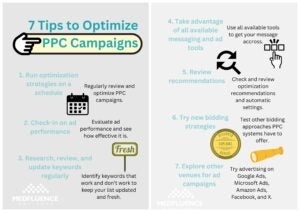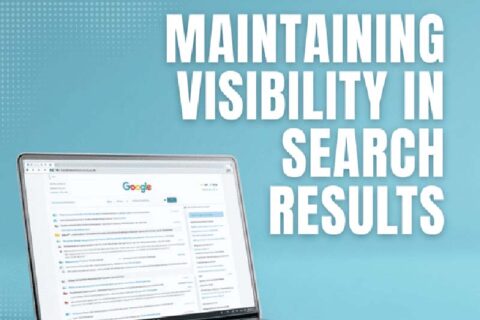How to Optimize PPC Campaigns: Run Ads Like a Pro With These 7 Tips

PPC (pay-per-click) campaigns remain one of the most effective marketing and advertising strategies for many businesses, no matter their operational size. Effective PPC campaigns help bring in new leads and drive sales and conversions to any business in any industry. PPC campaigns are not meant to be “set-it-and-forget-it” strategies; if you want it to be an effective marketing strategy, you should optimize your business’s PPC campaigns regularly.
Over time, more and newer strategies, campaign and advertising culture, and practices are developed and applied to marketing campaigns. But even with these endless developments, there are a few tips and strategies that remain the most effective and fundamental for any businesses running marketing and advertising campaigns like PPCs.
For what these timeless PPC campaign tips are, read more below.
What is PPC?
Whether you’re an experienced professional in PPC or just beginning to apply it to your business, establishing a clear understanding of what PPC is and what it entails should be your primary step. PPC means pay-per-click and it is a model of advertising in the digital world that allows advertisers and businesses to pay for PPC systems every time someone clicks on one of their ads. This, in turn, brings visitors to their website or a certain landing page they have set up.
When done right, a single click from one user can lead to a sales or lead conversion.
PPC advertising campaigns appear on various websites, search engines, social media platforms, and more. Search engine advertising is one of the most popular forms of PPC, with Google Ads as the most popular PPC system for many businesses.
How does PPC marketing work?
The basics of how PPC advertising campaigns work are as follows:
- Advertisers and businesses create ads.
- They choose a set of targeted keywords related to their business and ad.
- They will bid on said targeted keywords to tell the PPC system how much they’re willing to pay for the ad placement in Search Result Pages (SERPs) related to their business and targeted keywords.
- The ad’s Quality Score will be calculated based on the bid, the quality of the ad, and its relevance to the searcher’s keyword.
- This score will determine where your ad is placed on the search engine results page.
What is PPC Optimization?
PPC optimization is a set of processes and strategies applied to existing PPC campaigns to further improve their audience reach and effectiveness. These can be changes made to keywords, ad structure, campaign settings, landing pages, and other aspects of the advertising campaign.
As we’ve mentioned above, PPC campaigns are far from being “set-it-and-forget-it” marketing tactics. An effective PPC campaign will need constant optimization and improvement to make sure it’s bringing in the clicks, audience, and sales you’re hoping it would bring to your business.
Run PPC Campaigns With These 7 PPC Optimization Tips:
Once you’ve set up and paid for your PPC campaigns on your chosen PPC system, don’t just bury and forget it. Any smart advertiser would consistently optimize their PPC campaigns for the best maximum results.
With that said, here are 7 simple ways you can further optimize your PPC campaigns to further improve their reach and effectiveness:
1. Run optimization strategies on a schedule

The first thing you can apply to your business’s advertising and marketing campaigns is to set a regular schedule to check, review, and optimize existing PPC campaigns. This can be done weekly, bi-weekly, monthly, quarterly, or bi-annually, depending on personal goals and preferences. But remember, you might have to do certain tasks on different schedules so make sure you plan accordingly.
When running PPC campaigns and other types of advertising campaigns, you need to keep in mind that you will have to make adjustments and optimizations and run tests on a regular basis. This is to ensure that your advertising campaigns are bringing in the clicks, visitors, conversions, and sales you’re hoping for.
Regardless of the schedule you select and believe would be optimal for your business, the key is to stay committed to it. Pick a schedule that works for you and one that you find yourself having no trouble following.Stick to your regular schedule and concentrate on reviewing, optimizing, and testing what strategies work effectively for your business and which ones do not.
From there, you can plan what to further optimize and improve in your ad campaign to drive more traffic to your website and sales to your business. And if you have no idea where to start on scheduling (don’t worry, it happens), a quick internet search can lead you to all sorts of optimization calendars experts are more than willing to share. Tweak and adjust these ideas to a schedule that works for you.
2. Check-in on ad performance
Once you’ve set up and published a PPC campaign, you shouldn’t ever forget about it. To check how effective the advertising campaign is, it’s best to check its performance regularly. Most PPC systems like Google Ads and Microsoft Ads let advertisers easily check the performance of their ads and campaigns in their performance view tabs. Checking their performance will give you an idea of whether you should keep the campaign as it is, optimize it, or completely scrap it to make way for a completely new campaign.
Most advertisers also run multiple campaigns across multiple PPC networks. As the leading PPC systems, both Google and Microsoft allow you to easily check your ad performance on these networks. You only need to select this in their performance tabs.
Additionally, it’s crucial to evaluate ad performance relative to your expenditure. If the performance is robust and justifies the marketing cost, you should certainly continue the campaign. However, if your assessment during the ad performance check indicates that the marketing budget is being wasted, you have two options: optimize it for enhanced performance or discontinue it entirely to mitigate losses.
3. Research, review, and update keywords regularly
Researching target keywords relevant to your business and the products and services offered is a fundamental strategy for any marketing campaign. In PPC campaigns, you pay a certain amount per keyword; to ensure you’re getting the most for what you pay for, research and review each one regularly. Identify keywords that perform well and keywords that do not perform well so you can tailor your spending budget appropriately.
In your regular schedule of checking your ad performance, look closely at the existing keywords on your account. Categorize them into what you’re paying for but are not driving clicks and visitors or what you’re paying for that are driving clicks and converting to actual sales.
Additionally, research new keywords and update your list regularly to keep it fresh, potentially reaching a wider and more diverse set of audiences. Researching new keywords and updating your list regularly is another essential because you might be overlooking some converting keywords you should be paying attention to instead.
4. Take advantage of all available messaging and ad tools
When you’re advertising with PPC systems like Google Ads or Microsoft Ads, you are competing with hundreds of other businesses and advertisers also eyeing a high rank in SERPs.
Since you’re already paying for a placement, you don’t want your ad campaign to get lost and buried under the messages of other businesses and advertisers. And here’s how you make sure that doesn’t happen:
When setting up PPC campaigns, especially on search engine results pages, advertisers have an option called Responsive Search Ads (RSAs). RSAs are made up of 15 potential headlines with each headline can be made up of up to 30 characters. RSAs also include up to 4 descriptions, each with a maximum of 90 characters.
With that said, make sure you use all these messaging tools made available to advertisers. Be creative in the variety of brand messages you send through your ads. To get the most out of the amount you’re paying for ad placement in SERPs, don’t let these spaces and messaging tools go to waste. Experiment with a variety of messaging techniques. You never know – one message might connect to some users while a different variety of your message may resonate more with others.
Additionally, major PPC systems offer other ad tools for businesses advertising with them. These tools include business names and logos, photos, snippets, and site links. Make sure you fill all this necessary information out and that these spaces don’t go to waste. Take advantage of these tools for your ad campaign as they could bring in more clicks and traffic.
5. Review recommendations

PPC systems like Google Ads and Microsoft Ads give advertisers optimization recommendations for their ads and campaigns. They give these recommendations based on certain algorithms and sometimes based on the performance of your existing PPC campaign.
The thing is, these recommendations may not always be advantageous for you. Other times, however, they do make a positive impact on your campaign, so make sure you review these recommendations yourself and determine whether they have a positive or negative impact on both your campaign and your overall business performance.
Google Ads also makes it a point to recommend a fresh list of target keywords that may be relevant to your business and the products and services you offer. It would hurt no one, especially not your business, to take a look at these keyword recommendations. Since you should be researching and keeping your list fresh with new keywords, this might actually be a big help in that aspect. After all, Google Ads has sophisticated algorithms. This could open up new opportunities and allow your business to achieve an even further reach.
Be aware though, that these recommendations don’t only work for the current ad campaign you’re running but may also be of value to your other ad campaigns. So keep an eye on what these recommendations are and cross-check on how they could possibly impact other existing campaigns or campaigns you’re planning in the near future.
Another factor to remember is that sometimes, these recommended ad settings are automatically applied. These automatic settings can either benefit or hinder your ad campaign performance, so the decision to keep them enabled or disable them is yours to make, depending on your review of the ad performance, as we’ve explained above.
As you can see, knowing how to review these recommendations and automatic settings is key to knowing what to do next.
6. Try new bidding strategies
When you’re paying for ad placement over a variety of networks and platforms, you are essentially bidding for a place on their page. Campaigns with a high score, based on quality, alongside effective bidding strategies, are more likely to end up coming out on top thus gaining more clicks and visits.
Even with an effective bidding strategy already in place that provides good results, it’s always prudent to revisit all the available bidding strategies a system offers. Test out other bidding strategies even if you have one that already works for you. After all, there are several adjustments PPC campaign systems make regularly.
Evaluate these bidding strategies and experiment with alternative approaches to see if there are any untapped opportunities. This presents an excellent opportunity to introduce variety and potentially uncover new, unexpected campaign outcomes.
7. Explore other venues for ad campaigns
While Google Ads is the leading PPC marketing system, there are other popular avenues and networks you can look into. Some systems that many businesses flock to include major social media platforms like Facebook and X (formerly Twitter).
Both Microsoft Ads and Amazon Ads also present new avenues for PPC ad campaigns. Try your hand at advertising with these platforms and see how they perform.
After a bit of trial and error, you will have a much clearer insight into what channels work best for your business and which ones deliver the most conversions. Once you have that data, stick with and focus on the channels that work.
Optimize PPC Campaigns With 7 Simple Tips Summary
When you’re spending on PPC campaigns, you want to get the best results, leads, and conversions. PPC ads are far from being “set-it-and-forget-it” strategies. Even when you find something that works well for your business, it’s always a good idea to revisit your strategies and optimize where needed.
Here are simple tips you can try to further optimize your PPC campaigns and drive more sales into your business:
- Run optimization strategies on a schedule
- Check in on ad performance
- Research, review, and update keywords regularly
- Take advantage of all available messaging and ad tools
- Review recommendations
- Try new bidding strategies
- Explore other venues for ad campaigns
Exploring these optimization strategies can yield either positive or negative effects on your ads and marketing campaigns. However, the crucial aspect is to experiment with them, consistently test their effectiveness, and update your data to determine which strategies are successful and which ones are not.



